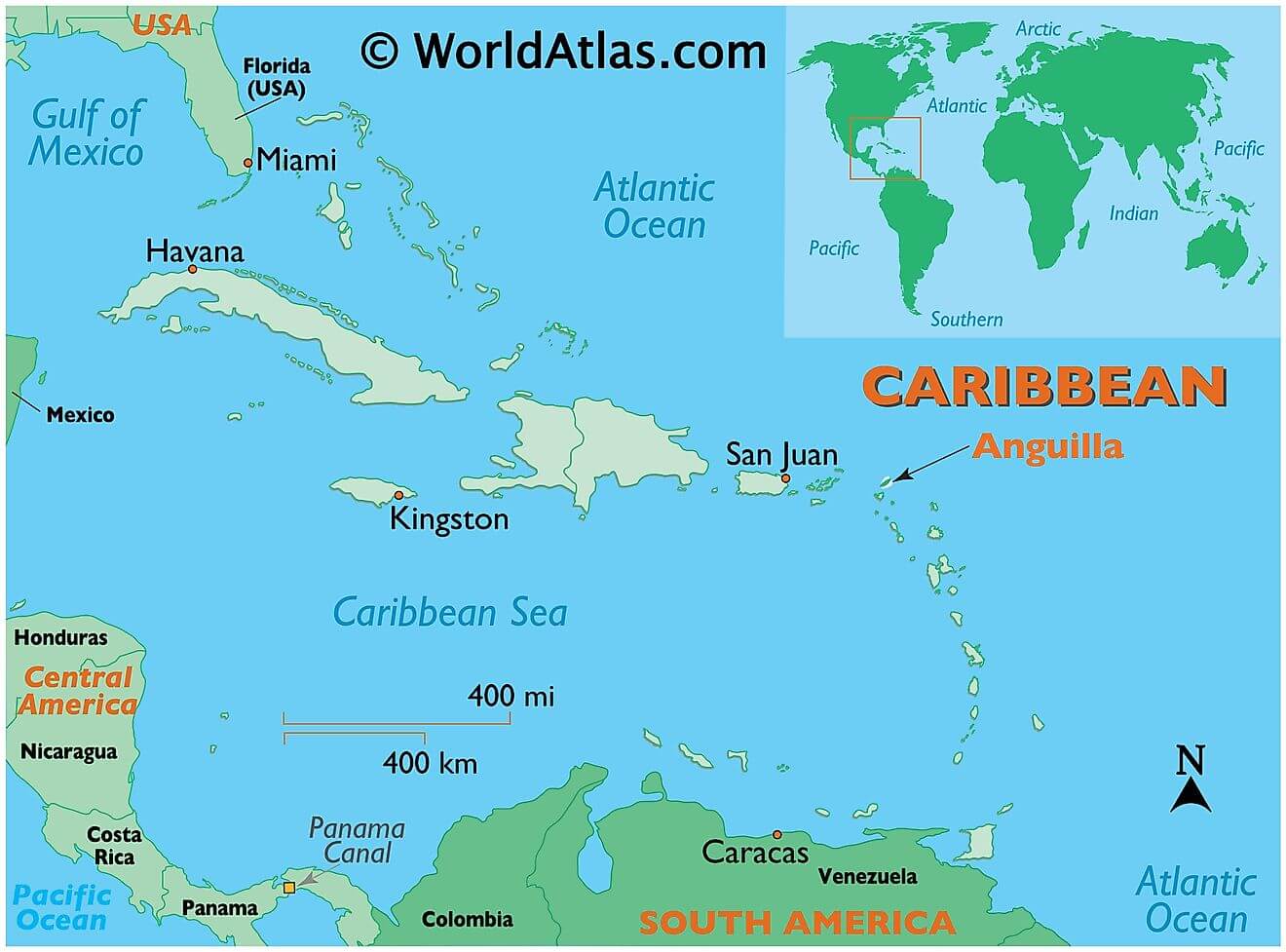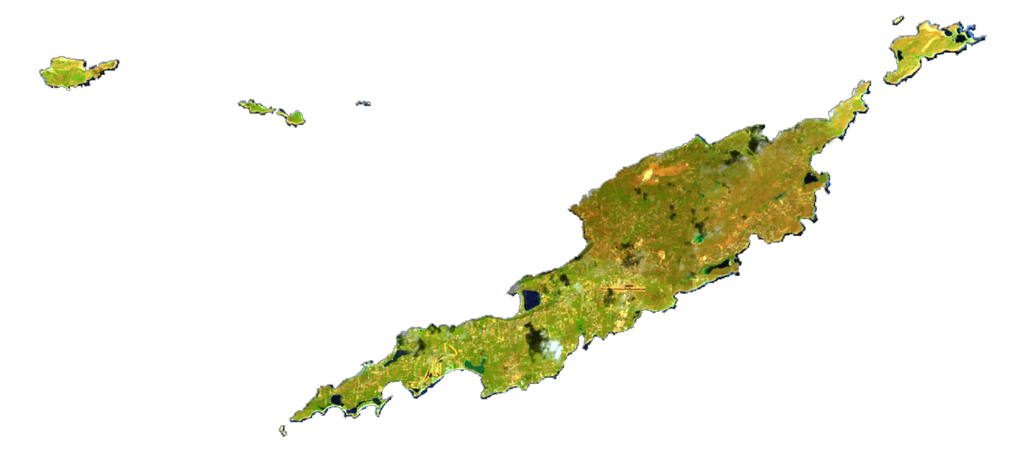Ringed by coral reefs and white sand beaches, Anguilla (a British Overseas Territory), is a mostly flat, low-lying island of coral and limestone; located in the north-eastern Caribbean Sea, east of Puerto Rico and US Virgin Islands.
As observed on the physical map of Anguilla above, there are no permanent rivers or streams on the island, and the name of the island is derived from its long thin shape.
Anguilla’s highest point is Crocus Hill, with an elevation of only 213ft above sea level. A yellow, upright triangle marks its position on the map.
Anguilla’s territory includes a number of smaller offshore islands and cays, mostly tiny and uninhabited. The major ones include: Anguillita, Dog Island, Prickly Pear Cays, Sandy Island, Scrub Island, Little Scrub, Scilly Cay, Seal Island and Sombrero (also known as Hat Island).
Discover the beauty of Anguilla with this interactive map. From its stunning beaches to its unique culture and rich history, this Caribbean island has something for everyone. Get an up-close look at the satellite imagery, settlements, seaports, bays, points, harbors, and its international airport. Explore the smaller islands like Scrub Island, Prickly Pear Cays, and Dog Island in the Caribbean Sea.
Location Maps
Where is Anguilla?
Anguilla is a British Overseas Territory located in the Caribbean. It consists of the main island of Anguilla as well as several smaller islands. The island is generally low-lying and made up of limestone and coral.
Anguilla lies north of the Leeward Islands and is part of the Lesser Antilles. It is situated east of Puerto Rico and the Virgin Islands, as well as north of Saint Martin, separated by the Anguilla Channel.
The Valley is the capital of Anguilla and is the main town of the island. At 73 meters (240 ft), Crocus Hill is Anguilla’s highest peak, situated near The Valley.
Altogether, Anguilla occupies a total area of 91 square kilometers (36 sq mi). In comparison, it is slightly larger than Saint Martin but smaller than Montserrat. Its size is approximately 26 kilometers (16 miles) long by 5 kilometers (3 miles) wide.
High Definition Political Map of Anguilla
History
Anguilla was first settled by Indigenous Amerindian peoples who migrated from South America. The earliest Native American artefacts found on Anguilla have been dated to around 1300 BC; remains of settlements date from AD 600. There are two known petroglyph sites in Anguilla: Big Spring and Fountain Cavern. The rock ledges of Big Spring contain over 100 petroglyphs (dating back to AD 600-1200), the majority consisting of three indentations that form faces.
Precisely when Anguilla was first seen by Europeans is uncertain: some sources claim that Columbus sighted the island during his second voyage in 1493, while others state that the first European explorer was the French Huguenot nobleman and merchant René Goulaine de Laudonnière in 1564. The Dutch West India Company established a fort on the island in 1631. However, the Company later withdrew after its fort was destroyed by the Spanish in 1633.
Traditional accounts state that Anguilla was first colonised by English settlers from Saint Kitts beginning in 1650. The settlers focused on planting tobacco, and to a lesser extent cotton. The French temporarily took over the island in 1666 but returned it to English control under the terms of the Treaty of Breda the next year. Major John Scott who visited in September 1667, wrote of leaving the island “in good condition” and noted that in July 1668, “200 or 300 people fled thither in time of war”. The French attacked again in 1688, 1745 and 1798, causing much destruction but failing to capture the island.
It is likely that the early European settlers brought enslaved Africans with them. Historians confirm that African slaves lived in the region in the early 17th century, such as slaves from Senegal living on St Kitts in the mid-1600s. By 1672 a slave depot existed on the island of Nevis, serving the Leeward Islands. While the time of African arrival in Anguilla is difficult to place precisely, archival evidence indicates a substantial African presence of at least 100 enslaved people by 1683; these seem to have come from Central Africa as well as West Africa. The slaves were forced to work on the sugar plantations which had begun to replace tobacco as Anguilla’s main crop. Over time the African slaves and their descendants came to vastly outnumber the white settlers. The African slave trade was eventually terminated within the British Empire in 1807, and slavery outlawed completely in 1834. Many planters subsequently sold up or left the island.
During the early colonial period, Anguilla was administered by the British through Antigua; in 1825, it was placed under the administrative control of nearby Saint Kitts. Anguilla was federated with St Kitts and Nevis in 1882, against the wishes of many Anguillans. Economic stagnation, and the severe effects of several droughts in the 1890s and later the Great Depression of the 1930s led many Anguillans to emigrate for better prospects elsewhere.
Full adult suffrage was introduced to Anguilla in 1952. After a brief period as part of the West Indies Federation (1958–62), the island of Anguilla became part of the associated state of Saint Kitts-Nevis-Anguilla with full internal autonomy in 1967. However many Anguillans had no wish to be a part of this union, and resented the dominance of St Kitts within it. On 30 May 1967 Anguillans forcibly ejected the St Kitts police force from the island and declared their separation from St Kitts following a referendum. The events, led by Atlin Harrigan and Ronald Webster among others, became known as the Anguillan Revolution; its goal was not independence per se, but rather independence from Saint Kitts and Nevis and a return to being a British colony.
With negotiations failing to break the deadlock, a second referendum confirming Anguillans’ desire for separation from St Kitts was held and the Republic of Anguilla was declared unilaterally, with Ronald Webster as president. Efforts by British envoy William Whitlock failed to break the impasse and 300 British troops were subsequently sent in March 1969. British authority was restored, and confirmed by the Anguilla Act of July 1971. In 1980, Anguilla was finally allowed to formally secede from Saint Kitts and Nevis and become a separate British Crown colony (now a British overseas territory). Since then, Anguilla has been politically stable, and has seen a large growth in its tourism and offshore financing sectors.
Physical Map of Anguilla

Geography
Anguilla is a flat, low-lying island of coral and limestone in the Caribbean Sea, measuring some 16 miles (26 km) long and 3.5 miles (6 km) in width. It lies to the east of Puerto Rico and the Virgin Islands and directly north of Saint Martin, separated from that island by the Anguilla Channel. The soil is generally thin and poor, supporting scrub, tropical and forest vegetation. The terrain is generally low-lying, with the highest terrain located in the vicinity of The Valley; Crocus Hill, Anguilla’s highest peak at 240 feet (73 m), lies in the western regions of the town.
Anguilla is noted for its ecologically important coral reefs and beaches. Apart from the main island of Anguilla itself, the territory includes a number of other smaller islands and cays, mostly tiny and uninhabited:
- Anguillita
- Blowing Rock
- Dog Island
- Little Scrub Island
- Prickly Pear Cays
- Scrub Island
- Seal Island
- Sombrero, also known as Hat Island
- Sandy Island
- Scilly Cay
Geology
Anguilla (and the wider Anguilla Bank) is of volcanic origin, lying on the Lesser Antilles volcanic island arc, and tuffs and volcaniclastic breccias of Eocene age are exposed locally on the island. The island was largely submerged during the Miocene, leading to the formation of the reefal limestone Anguilla Formation, which was subsequently tectonically uplifted and cover most of the island today. Since the late Pleistocene, however, Anguilla has undergone tectonic subsidence at a rate of around 1-2mm/yr.
Climate
Northeastern trade winds keep this tropical island relatively cool and dry. Average annual temperature is 80 °F (27 °C). July–October is its hottest period, December–February, its coolest.
Rainfall averages 35 inches (890 mm) annually, although the figures vary from season to season and year to year. The island is subject to both sudden tropical storms and hurricanes, which occur in the period from July to November. The island suffered damage in 1995 from Hurricane Luis and severe flooding 5 to 20 feet (1.5 to 6 metres) from Hurricane Lenny in 1999.





